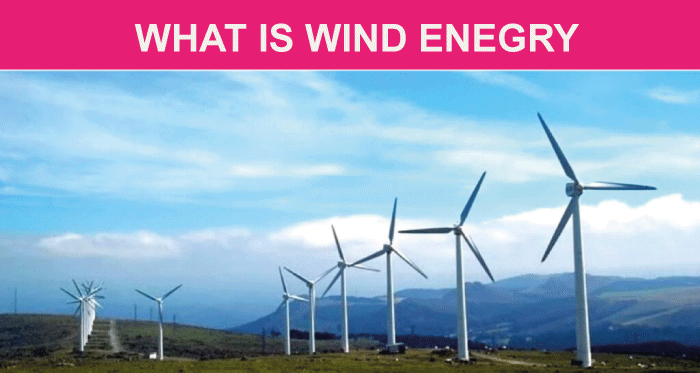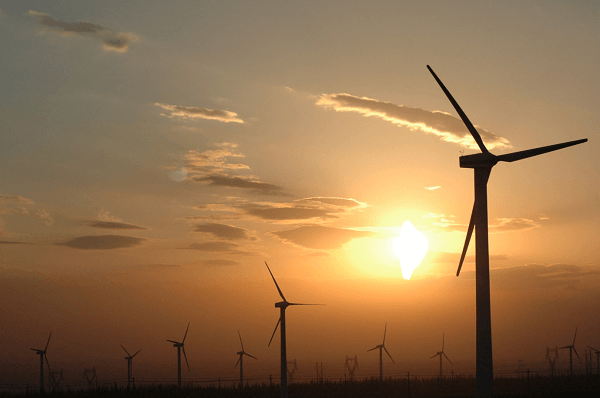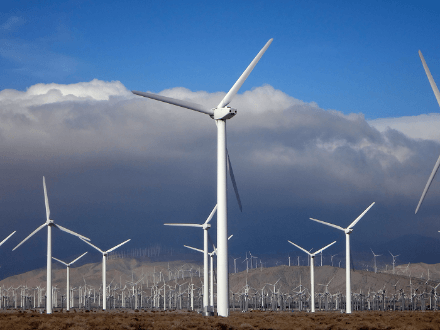Wind Energy DefinitionWind EnergyElectricity generated by the air flowing naturally through the Earth's atmosphere is known as wind energy. It has a much lower effect on the environment and climate than burning fossil fuels because it is a renewable resource that will not be exhausted through use. A set of 8-foot sails placed to catch the prevailing winds and turn a stone to grind grain, or a gristmill, are examples of basic wind energy generators. Alternately, it could be as complicated as a 150-foot vane rotating a generator that generates electricity stored in a battery or spread across a power distribution system. There are other wind turbines without blades. As of 2021, about 67,000 wind turbines were operating in the United States, located in 44 states, Guam and Puerto Rico. 8.4% of the electricity produced in the U.S. in 2020 came from wind energy. It meets around 6% of the global electricity demand. The amount of wind energy is increasing by roughly 10% annually. It is an important component of policies designed to fight climate change and promote sustainable development in several nations, including India, China, Germany, and the U.S. 
Wind Energy DefinitionPeople use wind energy in several ways, from the simple (it is still utilized to pump water for cattle in more remote regions) to the increasingly complex?think of the hundreds of turbines that cover the hills that cross California's Interstate 580. The basic elements of any wind energy mechanism are quite comparable. A drive shaft is attached to blades of various sizes and shapes, and then a pump or generator either utilizes or gathers wind energy. A windmill uses wind energy directly to drive mechanical motion, such as grinding grain or pumping water; a wind turbine uses wind energy to generate electricity. A turbine system needs other parts, such as a battery for storing electricity, or it could be connected to a system for distributing power, such as power lines. Nobody truly knows when humans first learned to use wind power. However, it is known that in approximately 5,000 BC, boats were being moved on Egypt's Nile River using wind power. In the Middle East, hand-woven windmill blades were used to crush grain by 200 BC, and in China, primitive water pumps were operated by the wind. In the end, every stage of food production there involved using windmills and pumps. The idea eventually made its way to Europe, where the Dutch constructed enormous wind pumps for draining wetlands, and from there, it made its way to the Americas. Wind Energy BasicsNatural processes such as the heating of the atmosphere by the sun, variations in the Earth's surface, and the planet's rotation all contribute to the production of wind. The impact of water bodies, forests, meadows, and other vegetation, as well as elevation variations, can cause the wind to rise or decrease. Although there are large differences in wind patterns and speeds across the terrain and throughout the year, some variations are predictable enough to be considered when planning. Site SelectionThe tops of rounded hills, broad plains (or open ocean for offshore wind), and mountain ranges where the wind is naturally pumped through (creating regular high wind speeds) are the greatest places for installing a wind turbine. The higher the location, the better since higher places usually have more wind. 
An essential tool for choosing a wind turbine location is wind energy forecasts. This information can be found in various wind speed maps and information from the National Oceanic and Atmospheric Administration (NOAA) or the NREL (National Renewable Energy Laboratory) in the United States. The next step is to conduct a site-specific assessment to evaluate the local wind conditions and choose the optimal location for the wind turbines to achieve maximum efficiency. Projects on land measure wind direction, speed, turbulence, temperature, and humidity for at least a year. Turbines that produce predictable outputs can then be created once that information has been established. The wind does not entirely determine the location of wind turbines. The proximity of the wind farm to electrical lines (and cities that can use the power), potential interference with nearby air traffic, fundamental rock formations and faults, bird and bat flight patterns, and the neighborhood's impact (noise and other potential effects) are all factors that must be taken into account by wind farm builders. Most larger wind projects are built to last at least 20 years if not more. Therefore, these challenges must be taken into account over the long term. Types of Wind EnergyUtility Scale Wind EnergyThese are big wind farms established to provide energy to a utility company. They sometimes replace or supplement coal-fired or natural gas power plants and are comparable in size. Currently, these systems provide about 8.4% of all the energy in the United States. They typically consist of turbines larger than 100 kilowatts in size that are installed together to provide significant power. Offshore Wind EnergyThese are usually utility-scale wind energy initiatives scheduled in waters off coastal areas. They can produce a tonne of electricity adjacent to bigger cities, which in most of the U.S. tend to be concentrated closer to the coast. According to the U.S. Department of Energy, the wind blows more frequently and strongly offshore than on land. The International Energy Agency estimates that wind energy can supply more than 18 times what the world requires. Distributed or small-scale wind powerThe examples above are the opposite of this form of wind energy. These tiny wind turbines are used to meet the energy requirements of a location or area. These turbines periodically connect to the larger electricity distribution system while operating off-grid. These smaller installations (5 kilowatts) can be found in residential settings where, depending on the weather, they may meet all or most of the home's energy needs. Medium-sized installations (20 kilowatts or so) can be found in industrial or community settings. They may be used as a renewable energy system component that includes solar power, geothermal energy, or other energy sources. How Does Wind Energy Work?A wind turbine's purpose is to harness the wind's kinetic energy by using blades of some type whose shapes can change. Similar to how a sail is raised to boost a boat, the wind lifts the blades as it passes over them. The wind's force causes the blades to turn, which moves the driving shaft to which they are attached. The energy from that shaft then drives a particular type of pump, such as a windmill that directly rotates a stone over grain or a generator that turns out electricity that can be utilized immediately or stored in a battery. The following steps are involved in the process of a wind turbine that produces electricity: Wind Pushes Blades A windmill or wind turbine should ideally be situated where the wind blows frequently and reliably. Specially constructed blades are pushed by air movement, which enables the wind to drive them as easily as possible. The design of a blade can cause it to be pushed either upwind or downwind of its location. Kinetic Energy Is Transformed The free energy produced by the wind is referred to as kinetic energy. Before we can use or store that energy, it must be converted into a usable form of power. Kinetic energy changes into mechanical energy when the wind pushes the windmill blades. The motion of the blades then turns a driving shaft. 
Electricity Is Generated In a wind turbine, a rotating driving shaft is coupled to a gearbox, which multiplies the rotation's speed by 100 to spin a generator. As a result, the gears eventually spin a lot faster than the wind-driven blades. These gears can power an electricity-generating generator if they accelerate to a high enough speed. Engineers are developing direct drive generators, which can operate at lower speeds (so they don't need a gearbox), to replace the turbine's most expensive and heavy component?the gearbox. Electricity Is Used or Stored Electricity generated by a wind turbine can be used on the location (more likely in small or medium-sized wind projects), provided to transmission lines to be used immediately, or stored in a battery. The future of wind energy depends on more effective battery storage. With more storage space, electricity from windy days may supplement electricity on quieter days. Then, wind variations would be less of a barrier to producing consistent electricity from the wind. Wind FarmA wind farm is a group of wind turbines that function as a special power plant to generate electricity from the wind. A wind farm could consist of a few or hundreds of wind turbines operating in the same region, whether on land or offshore because there is no formal criterion for the number of turbines in an installation to qualify as a wind farm. Advantages of Wind Energy
For example, a small turbine can power a house or farm building, a huge turbine can power an industrial facility, and a field of enormous turbines can generate enough energy for an entire city. Disadvantages of Wind Energy
Next TopicWorld Definition
|
 For Videos Join Our Youtube Channel: Join Now
For Videos Join Our Youtube Channel: Join Now
Feedback
- Send your Feedback to [email protected]
Help Others, Please Share










